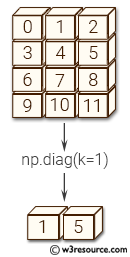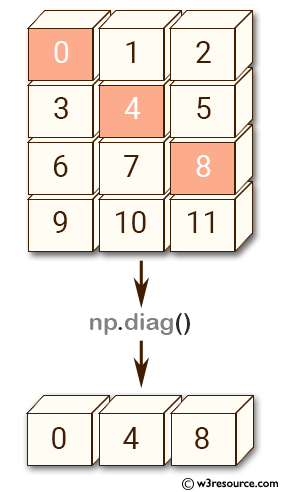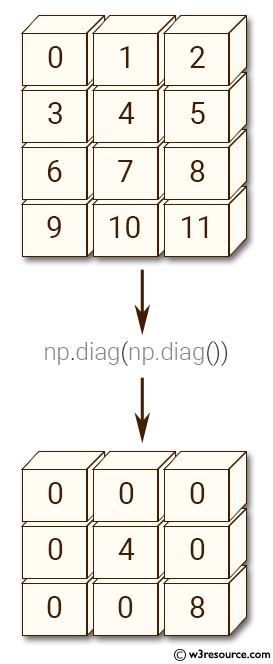NumPy: diag() function
numpy.diag() function
The diag() function is used to extract a diagonal or construct a diagonal array.
Syntax:
numpy.diag(v, k=0)

Version: 1.15.0
Parameter:
| Name | Description | Required / Optional |
|---|---|---|
| v | If v is a 2-D array, return a copy of its k-th diagonal. If v is a 1-D array, return a 2-D array with v on the k-th diagonal. | Required |
| k | Diagonal in question. The default is 0. Use k>0 for diagonals above the main diagonal, and k<0 for diagonals below the main diagonal. | optional |
Return value:
out : ndarray - The extracted diagonal or constructed diagonal array.
Example-1: NumPy.diag() function
>>> import numpy as np
>>> a = np.arange(12).reshape((4,3))
>>> np.diag(a)
array([0, 4, 8])
Pictorial Presentation:

Example-2: NumPy.diag() function
>>> import numpy as np
>>> a = np.arange(12).reshape((4,3))
>>> np.diag(a, k=1)
array([1, 5])
Example-3: NumPy.diag() function
>>> import numpy as np
>>> a = np.arange(12).reshape((4,3))
>>> np.diag(a, k=-1)
array([ 3, 7, 11])
Example-4: NumPy.diag() function
>>> import numpy as np
>>> a = np.arange(12).reshape((4,3))
>>> np.diag(np.diag(a))
array([[0, 0, 0],
[0, 4, 0],
[0, 0, 8]])
Pictorial Presentation:

Python - NumPy Code Editor:
Previous: ogrid()
Next: diagflat()
- New Content published on w3resource:
- HTML-CSS Practical: Exercises, Practice, Solution
- Java Regular Expression: Exercises, Practice, Solution
- Scala Programming Exercises, Practice, Solution
- Python Itertools exercises
- Python Numpy exercises
- Python GeoPy Package exercises
- Python Pandas exercises
- Python nltk exercises
- Python BeautifulSoup exercises
- Form Template
- Composer - PHP Package Manager
- PHPUnit - PHP Testing
- Laravel - PHP Framework
- Angular - JavaScript Framework
- Vue - JavaScript Framework
- Jest - JavaScript Testing Framework
